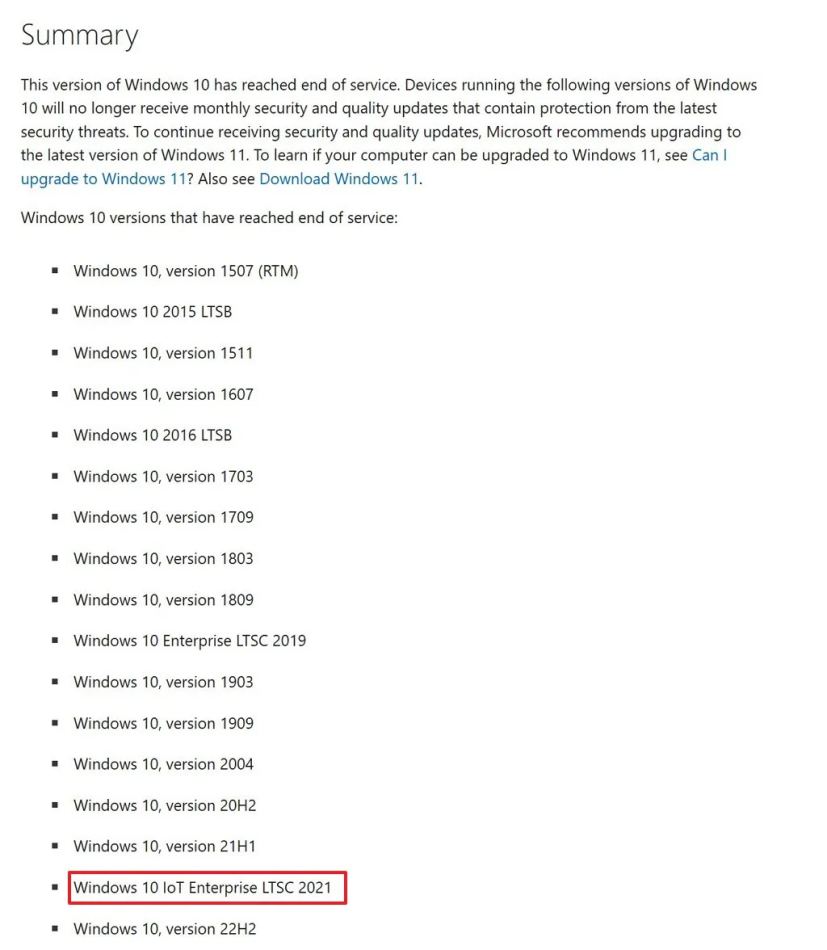
- Windows 10 LTSC 2021 and IoT LTSC 2021 remain fully supported until 2027 and 2032, even though some users are seeing a false “Your version has reached end of support” message.
- The alert is a known glitch and doesn’t affect updates or security patches.
- You can safely ignore it as Microsoft will continue delivering updates normally.
UPDATED 10/18/2025: Microsoft has officially ended support for Windows 10 as of October 14, 2025, meaning most versions of the operating system will no longer receive monthly security or quality updates. However, despite this milestone, some editions of Windows 10, particularly LTSC (Long-Term Servicing Channel) and IoT LTSC, remain fully supported.
Recently, users running these versions have reported seeing the message “Your version has reached end of support” on Windows 10 LTSC 2021 (version 21H2). However, according to Microsoft’s lifecycle documentation for LTSC and IoT LTSC, as well as user reports, this alert appears to be a temporary glitch, not an indication that support has actually ended.
Why the “Your version has reached end of support” message
A thread on r/WindowsLTSC recently surfaced after several users on Windows 10 Enterprise LTSC 2021 (version 21H2) received the message that their version had reached the end of support. The post quickly drew attention from the community, with multiple users confirming the issue even on clean installations.

One commenter noted that “it may just be a glitch that will get fixed with the next update. Microsoft seems to periodically forget that LTSC exists. They tried pushing 22H2 update when it first came out, for example.”
Others noted that despite the message appearing, security updates continue to install successfully, indicating a potential issue with the interface or update service. Some members also mentioned that the company is aware of the issue and that devices will continue receiving updates normally.
Versions of Windows 10 that are still supported
While most consumer editions of Windows 10 have reached end of life, the following LTSC versions continue to receive security and quality updates:
- Windows 10 Enterprise LTSC 2021 (21H2): Supported until January 12, 2027
- Windows 10 IoT Enterprise LTSC 2021 (21H2): Supported until January 13, 2032
However, it’s important to note that the Windows 10 update history page is also listing the “Windows 10 IoT Enterprise LTSC 2021” as a version that has reached the end of support. However, this can also be considered a publishing mistake.
Since this article was published, Microsoft has updated its original post to ensure that the LTSC and IoT LTSC versions from 2021 are still supported.

These builds are part of Microsoft’s long-term servicing model, designed for enterprise and specialized systems (such as medical equipment, kiosks, or industrial controllers) that require maximum stability and minimal feature changes.
If you’re seeing the “end of support” alert while running these editions, you can safely ignore it. Your device remains supported.
Versions of Windows 10 that have reached end of service
All other versions of Windows 10 have officially reached the end of support as of October 14, 2025. This includes:
- Version 22H2 (final public release)
- Version 21H1
- Version 20H2
- Version 2004
- Version 1909
- Version 1903
- Version 1809
- Version 1803
- Version 1709
- Version 1703
- Version 1607
- Version 1511
- Windows 10 2015 LTSB
- Version 1507 (RTM)
Devices running any of these editions will no longer receive monthly updates, leaving them exposed to unpatched security vulnerabilities.
Extended Security Updates (ESU) program
If you want to continue using Windows 10 securely after October 14, 2025, you have to enroll in the Extended Security Updates (ESU) program.
The program is technically a paid service, and it’s been primarily designed for organizations. However, regular consumers can also pay for it or obtain it for free.
For example, the first option involves backing up your data to OneDrive, whether or not you have a Microsoft 365 subscription.
The second option is to redeem 1000 points if you have already signed up for the Microsoft Rewards program.
Finally, you can pay $30 to enroll in the ESU program and continue receiving security updates for one more year, until October 13, 2026. However, Microsoft has recently changed the requirements for European users, and now, if you’re in Europe, you don’t have to back up your data or redeem points to sign up.
These updates only include security patches (not new features, bug fixes, or improvements) and are intended as a short-term solution before upgrading to Windows 11 or another supported platform.
What’s the next step
If you’re using Windows 10 Enterprise LTSC 2021 or Windows 10 IoT Enterprise LTSC 2021, you do not need to take any immediate action. Microsoft will continue to support these editions for years to come, despite the incorrect notification.
If you’re on Windows 10 22H2 or any earlier version, your options include upgrading to Windows 11, enrolling in the ESU program, or switching to Linux Mint or ChromeOS Flex.
Microsoft has officially ended support for nearly all consumer versions of Windows 10, but LTSC 2021 and IoT LTSC 2021 remain fully supported. If you see the “Your version has reached the end of support” message, don’t panic. It has to be a display glitch, not the end of updates.
Update October 15, 2025: Microsoft has updated its official statement to confirm that the Windows 10 Enterprise LTSC 2021 and Windows 10 IoT Enterprise LTSC 2021 are still supported operating systems, as stated in this article. The company also removed Windows 10 Enterprise LTSC 2019 and Windows 10 2016 LTSB from the list.
Update October 18, 2025: Users are already reporting that they’re no longer seeing wrong notifications on the Windows Update settings, which indicates that Microsoft has already resolved this issue from its end. If you’re still seeing the “Your version has reached end of support” message, restart the computer, and click the “Check for updates” button on the settings page.
